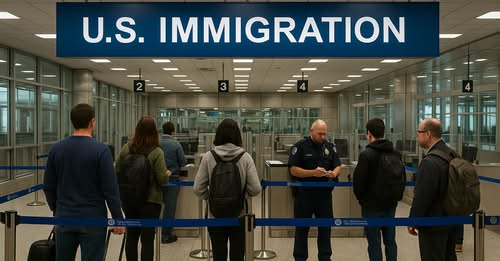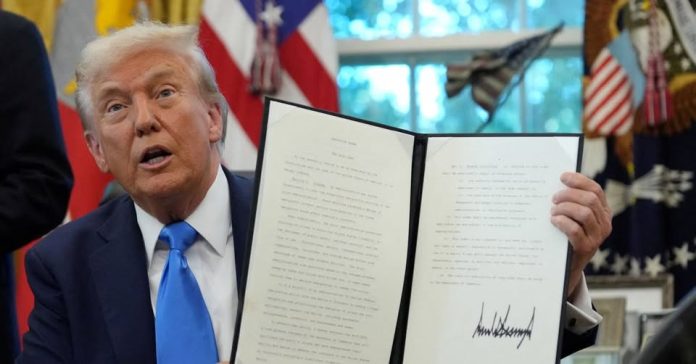Indian-American Dream Tested: New Fee for New Visas, Not for Those Who Already Hold Them
– Atoofa Nasiha
For decades, a stable career in the United States has been the dream of many Indian families. Securing an H-1B visa was not just about getting a job abroad; it became an identity of success, a symbol of achievement that reflected hard work, education, and the promise of a better future. For countless Indians, the H-1B pathway meant financial stability, opportunities for their children, and the pride of representing India in America’s competitive workforce.
But in September 2025, this dream encountered a serious obstacle. The Trump government introduced a $100,000 fee for new H-1B visa applications. This fee applies only to fresh petitions, while existing H-1B holders renewing their visas are exempt. (USCIS, White House clarification)
Why the Fee Was Introduced
The Trump administration stated that the fee aims to encourage employers to hire U.S. citizens or permanent residents rather than relying on foreign workers. It is part of broader changes to the skilled worker visa programme, intended to protect American jobs and adjust wage standards in sectors with high dependency on H-1B professionals. (Reuters)
Legal and economic arguments were used to support the fee. Critics say that without such measures, companies might continue to underpay foreign workers relative to U.S. workers. Supporters believe that by raising the cost dramatically, only those with high value or high salary offers will be able to justify sponsorship, which they claim could raise overall job quality and fairness. (Financial Times)
Who Is Affected
The new $100,000 fee applies only to new visa petitions filed after the effective date. It does not apply to:
- People who already hold H-1B visas;
- Renewals of existing H-1B visas; and
- Extensions or changes of employer, at least based on current clarifications.
This means current H-1B visa holders will not face the fee when renewing their status or re-entering the U.S., nor will it affect those already inside the U.S. under H-1B status. (White House press secretary Karoline Leavitt)
Timeline and Implementation
The proclamation introducing the fee took effect September 19, 2025. It is a one-time fee for new applicants and is expected to apply to new lottery cycles of H-1B visas, starting in early 2026. The policy is valid for at least one year. (USCIS and reporting)
 There has been confusion among tech companies and visa holders over travel restrictions, renewal, and whether the fee might later expand to cover more categories. Clarifications have attempted to reduce panic. (Washington Post; AP News)
There has been confusion among tech companies and visa holders over travel restrictions, renewal, and whether the fee might later expand to cover more categories. Clarifications have attempted to reduce panic. (Washington Post; AP News)
Economic Effects on Indian Americans
Indian professionals represent over 70% of H-1B visa holders. Many companies in the U.S. tech industry depend on them for specialised work. The new fee makes it much more expensive to hire new foreign workers, which may reduce job offers to Indians or shift hiring patterns toward domestic employees. (Reuters)
Indian Americans who were planning to bring family members on H-1B sponsorship may face cancellation or delays. Those waiting by the visa lottery process will need to budget for the much higher cost. Some families may face financial stress due to these changes.
There is also concern for Indian tech companies that send staff to the U.S. under H-1B. Increased costs may reduce rotations, offshore work may increase, and contract pricing might go up. This could impact revenue and investment cycles. (Reuters)
Impact Back in India
India’s IT sector earns a very large share of its revenue from U.S. contracts. With fewer H-1B visas being used for new employees, Indian firms may face reduced demand for sending workers abroad, which could reduce foreign exchange income for many regions dependent on remittances and contracts. (Reuters)
Stock markets in India have already reacted. Major IT firms had share prices fall after the announcement of the fee. Investors are concerned about how quickly companies will adjust cost models. (Reuters)
Furthermore, smaller towns and states that rely on tech or diaspora remittances may feel effects more sharply. Reduced opportunities abroad often hit mid-level tech workers first, those who might not have savings or dual options.
Counterpoints, Adaptations, and Reactions
Industry bodies like NASSCOM in India have expressed concern but also appreciated that the fee does not affect existing visa holders or renewals. That clarification has brought some relief. (Reuters)
Some companies are exploring alternatives: hiring more people locally in the U.S., shifting work offshore, or using other visa categories such as L-1 or green card pathways. However, these options often come with additional costs and longer delays.
Indian Americans civil society and diaspora networks are organising to communicate the hardships, lobby for changes, and provide legal assistance for those uncertain about their case.
Long-Term Risks and Broader Impacts
The policy may discourage new foreign talent from applying, reducing diversity and skill inflow into the U.S. tech sector. Innovation could suffer if fewer international workers are able to join.
For India, decreased demand from U.S. markets may lead to slower growth of tech exports, potentially shrinking some sectors. Remittances may stabilise but growth may slow. Pressure will grow to build more domestic opportunities and reduce dependency on foreign work.
There is also a risk that educational choices may shift. With fewer opportunities abroad, students might reconsider degrees or specializations that were previously oriented toward U.S. job markets.
Reactions from the Community
The $100,000 fee for new H-1B visa applications has elicited strong reactions from both Indian professionals and political leaders:
A Reddit user shared, “And for those who lack compassion, shame on you. You didn’t have to see my mom crying because she was about to see me for the 1st time in a few months, that we were about to spend a week together for the first time in a few years!” (India Today)
Another individual remarked, “It’s crazy to see this, but with jobs shrinking for new grads, I think the US needs it. The consequences will be great for India. I personally know great engineers on H-1B visas who can build great things. Still, they were just working for an American company in Silicon Valley, probably no more now with this uncertainty.” (Money Control)
Former Niti Aayog CEO Amitabh Kant commented, “Donald Trump’s 100,000 H-1B fee will choke US innovation, and turbocharge India’s.” (The Times of India)
Rajeev Chandrasekhar, BJP Kerala State President, stated, “It is not something that is good for the American tech ecosystem.” (The Times of India)
Telangana Congress MP Mallu Ravi called the fee hike “almost a death blow” and urged for a special session of Parliament to address the issue. (The Times of India)
These statements highlight the concern, frustration, and uncertainty that the new policy has caused among Indian professionals and community leaders.
The $100,000 H-1B fee is a serious change. It was introduced to protect U.S. jobs and increase domestic hiring. It applies only to new H-1B petitions and not to those who already hold or renew the visa. For many Indian Americans, it brings worry about future job offers, family plans, and financial stability.
But there is some clarity and some room for adjustment. Existing visa holders are safe for now. Companies and governments are responding. Diplomacy and legal challenges may yet shape how this policy is enforced.
For Indian professionals, the path ahead may require adaptation: learning new visa routes, pushing for policy changes, or planning future moves with this new cost in mind.
The American dream may feel tested. But if people, communities, and leaders understand the changes clearly, prepare wisely, and support one another, this too could lead to new possibilities instead of limitations.




